Mechanism of action of anti-malarial drugs that can be used for treating cancer has been discovered. These drugs target the enzyme PPT1 and deactivate it to inhibit the growth of cancer cells.
- Anti-malarial drugs such as chloroquine have been used for treating cancer for several decades. But the mechanism of action of these drugs for inhibiting cancer cells was not known
- Anti-malarial drugs target and deactivate the enzyme palmitoyl-protein thioesterase 1 (PPT1) present in cancer cells. This causes a substantial inhibition of proliferation of the cancer cells, essentially halting the progression of cancer
- Elucidation of this mechanism of action of the anti-malarial drugs could facilitate the development of novel treatments against cancer
Read More..
Why is the Study So Important?
The importance of the study is explained by Dr. Ravi K. Amaravadi, the study’s co-senior author and an Associate Professor, Division of Hematology Oncology, Department of Medicine, Perelman School of Medicine, University of Pennsylvania. He indicated that the discovery of the PPT1 target was critical since chloroquines are currently being evaluated in clinical trials across the globe, including the University of Pennsylvania, and the new knowledge could bring about a paradigm shift in the way the clinical trial results are analyzed and interpreted.What is the Role of PPT1 in Cancer Cells?
The PPT1 enzyme is responsible for controlling the action of the mechanistic target of rapamycin (mTOR), a serine/threonine protein kinase that regulates cancer cells by modulating cell growth, cell proliferation, cell motility, and cell survival.Additionally, PPT1 also controls a process called autophagy, derived from the Greek words “auto” (self) and “phagy” (eating). It is a physiological process in the body that involves the removal of unnecessary cell components and allows their orderly degradation and recycling.
It has been previously shown by scientists at the University of Pennsylvania that these two processes work side-by-side – autophagy provides the nutrients to mTOR, which directs cell growth, and when nutrients are not required, mTOR shuts-off autophagy.
On the basis of their previous work, scientists used CRISPR/Cas9 to edit-out PPT1 to see whether its deletion from cancer cells has the same effect as when cancer cells are treated with chloroquine.
“The edited cells look like they’ve been treated with a drug, and they grow significantly slower than the unedited cells,” Dr. Amaravadi said. “We also compiled data from existing databases and found PPT1 is both highly expressed in most cancers and also associated with poor outcomes.”
Proof of Concept
Scientists proved the concept by treating melanoma (a very severe type of skin cancer) cells with DC661, which is a dimer of the antimalarial drug quinacrine. The DC661 molecule specifically targets the PPT1 enzyme and kills many types of cells, both in vitro and in vivo.“Our previous studies on the chemistry of these compounds is crucial to specifically targeting PPT1, and we used that knowledge to create a potent form of the drug that we’ve now shown is more effective at slowing the growth of cancer cells in mice than the monomeric chloroquines currently under study in clinical trials,” said Dr. Jeffrey D. Winkler, Merriam Professor of Chemistry and Undergraduate Chair, Department of Chemistry, School of Arts and Sciences, University of Pennsylvania, and the second co-senior author.
The study was driven by the co-lead authors, Dr. Vito W. Rebecca, PhD, who was then a Postdoctoral Researcher in Dr. Amaravadi’s group, and Dr. Michael C. Nicastri, PhD, who was then a graduate student in Dr. Winkler’s group.
Concluding Remarks
Dr. Amaravadi explained that when the pieces of the puzzle are put together, it becomes highly promising. “We now have a specific molecular target in cancer, as well as a potent way to reach it,” Dr. Amaravadi said. “It not only provides a new context for current clinical trials involving hydroxychloroquine, but also, with further development of these compounds toward clinical drug candidates, it opens the door for head-to-head testing of our compounds or their optimized derivatives versus current chloroquines to see which is more effective.”This study was supported by grants from the National Institutes of Health (NIH), Bethesda, USA.
Reference:
- PPT1 promotes tumor growth and is the molecular target of chloroquine derivatives in cancer - (http://cancerdiscovery.aacrjournals.org/content/candisc/early/2018/11/13/2159-8290.CD-18-0706.full.pdf)
Source-Medindia











